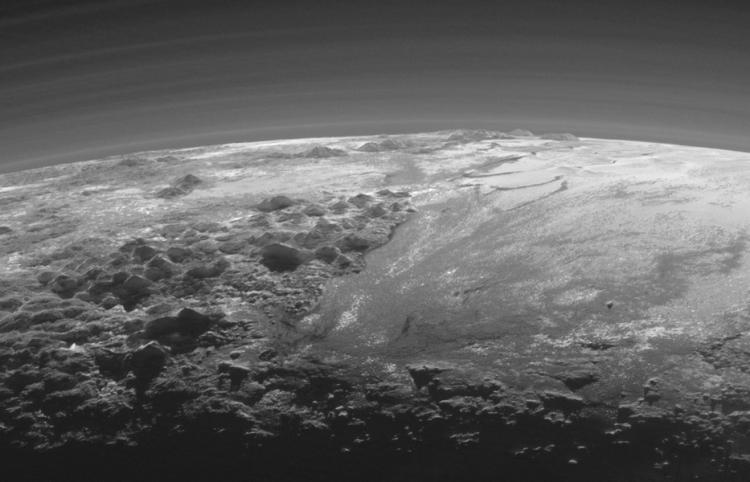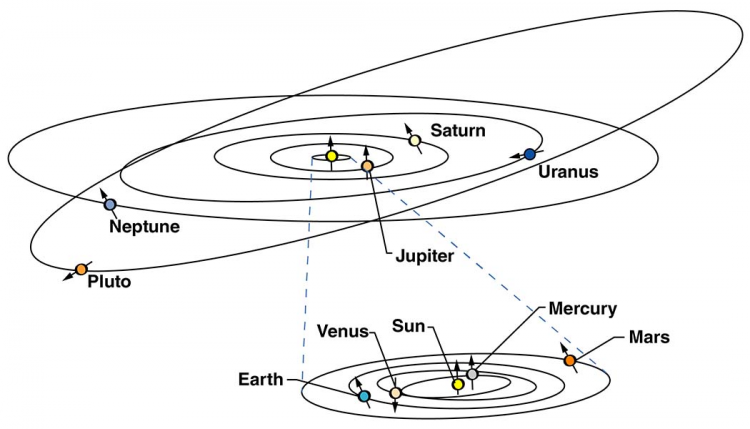In many ways, Pluto is an oddball. Sitting out at the edge of the solar system, the tiny world was long thought to be little more than a frozen wasteland. Yet when NASA’s New Horizons flew past the dwarf planet three years ago, the spacecraft revealed an active and varied landscape. On Pluto, smooth glacial plains give way to towering mountain ranges and ice-spewing volcanoes.
Among its most striking features is the complexity and dynamism of Pluto’s tenuous atmosphere. Before the flyby, researchers knew Pluto’s atmosphere to be dominated by nitrogen and methane, and very thin. But decades of distant study left many properties unknown, such as the exact surface pressure or even how Pluto managed to hang on to its atmosphere at all.
New Horizons has helped solve many such mysteries, revealing the intimate connection of Pluto’s atmosphere to its fascinating geology and surface chemistry, says Randy Gladstone, a planetary scientist at the Southwest Research Institute (SwRI) in San Antonio and leader of the New Horizons’ atmospheric team.
A perpetual haze that cools the atmosphere plays an important role in shaping the icy landscape. The atmosphere also experiences cycles known as mega-seasons, lasting millions of years. These long-term weather patterns encourage the formation of some of Pluto’s alien scenery: ridges sharp as knives, dunes of methane ice grains and frozen lakes of liquid nitrogen.

One of the biggest scientific surprises to emerge from the Pluto flyby were new details of the dwarf planet’s atmosphere. This image, taken of Pluto’s horizon near sunset by New Horizons, revealed more than a dozen layers of haze.
CREDIT: NASA/JHUAPL/SwRI
Before New Horizons, the only way to glimpse Pluto’s atmosphere was during an occultation. As seen from Earth, Pluto will occasionally pass in front of a distant star, causing the star’s light to slightly dim. Starting in 1988, astronomers trained telescopes on Pluto as its atmosphere imparted telltale clues onto the starlight, showing that its gases included nitrogen, methane and carbon monoxide. The observations also suggested that Pluto has distinct atmospheric layers.
Although Pluto’s surface temperature is an arctic minus 231 degrees Celsius, researchers had predicted that there should be a relatively balmy layer in the atmosphere that peaked at around minus 173°C. But at this temperature, molecules of nitrogen and methane would have had enough energy to shoot out into space.
New Horizons explained why they didn’t. The probe detected soot-like material made when ultraviolet light hits methane, creating more complex carbon compounds such as acetylene, ethylene and ethane. These stick together in fluffy little aggregates that form a haze, adding a blue tinge visible in some New Horizons images. By absorbing infrared light, the shading haze keeps the atmosphere at a chilly minus 203°C, preventing it from warming up and sloughing off into space.
The spacecraft recorded as many as 20 distinct atmospheric layers, “which were amazing to see,” says planetary scientist Catherine Olkin of the SwRI’s campus in Boulder, Colorado.
Without its thin but protective atmospheric coating, Pluto’s surface would have been directly exposed to harsh radiation from the sun. Cold ices would have sublimated away, probably leaving the world a dried-out husk rather than the active body seen by New Horizons.
A smooth, icy glacier at Pluto’s heart (Tombaugh Regio) ends in the reddish-colored, crater-rich Cthulu Region, said to resemble a whale. Since New Horizons, scientists have come to a new understanding of just how much Pluto’s surface has been shaped by its atmosphere.
Some of Pluto’s colorful surface features can also be traced back to the haze. Even before New Horizons, Hubble Space Telescope images showed a high-contrast, mottled landscape. “One of the really interesting things about Pluto is you have some of the brightest, most reflective surfaces next to some of the darkest,” says planetary scientist Alissa Earle of the Massachusetts Institute of Technology in Cambridge.
The flyby mission photographed an enormous, whitish, heart-shaped region that the team named the Tombaugh Regio, after Clyde Tombaugh, Pluto’s discoverer. Directly next to this is a dark-reddish area, reminiscent of a whale, called Cthulhu Macula. The darker expanse is covered in tholins, complex organic molecules that form as methane and nitrogen interact in the atmosphere and subsequently rain down to the surface, accumulating over eons. The lighter Tombaugh Regio seems to be more geologically active, with nitrogen ice glaciers that spill down from mountain peaks and polygonal cracks suggesting a vast ocean beneath the ice. The churning ice mixes up the dusty tholins, brightening the Regio’s surface.

Not only is Pluto toppled on its axis, spinning sideways compared with the sun, it also moves along a tilted, eccentric orbit that changes in length over millions of years. The orbital fluctuations and tilt influence its mega-seasons.
CREDIT: NASA
Pluto’s tilt further influences how the atmosphere and surface interact. Researchers knew that Pluto’s axis of rotation is tipped far over on its side at a precipitous 120 degrees, compared with the Earth’s modest 23 degrees. Pluto’s pitch means that nearly an entire hemisphere is exposed to seasonal extremes, the equivalent of all of North America and Europe receiving months of almost endless daylight and then months of near-perpetual darkness. And because Pluto’s journey around the sun lasts 248 Earth years, each season endures for more than a century.
Pluto’s axial tilt changes over time, varying between 103 degrees and 127 degrees over nearly 3 million years. The length and orientation of the planet’s orbit also oscillate on cycles of nearly 4 million years, altering the amount of sunlight that various parts of the surface receive. During different eras in its past, Pluto probably had a wildly different climate, recent research suggests. During warmer spells in its mega-seasons, Pluto’s atmosphere may have been as much as 100 times thicker, giving it a surface pressure similar to present-day Mars.
While Pluto’s orbit cycles had been worked out before New Horizons’ encounter, the probe provided examples of the mega-seasons’ effects. “I really don’t know how we can explain all the things [seen] on the surface without a thicker atmosphere,” says planetary scientist and mission principal investigator Alan Stern of SwRI in Boulder. “There’s just too many weird pieces of evidence.”
One such feature seen in the spacecraft’s photographs is what’s known as bladed terrain or snakeskin — tall, razor-thin ridges up to 1,000-meters high that look like “somebody opened up a drawer and turned all the knives with their sharp edges up,” says geologist Jeffrey Moore of NASA’s Ames Research Center in Moffett Field, California.
The methane ice structures form only near the equator and at the highest elevations. After working out how the mega-seasons would change the temperature of different parts of the surface, Moore concluded that methane ice was probably deposited at these locations during colder periods. The blocks are now being eroded and sculpted in the warmer modern-day environment.
Warmer spells in Pluto’s mega-seasons could also explain other strange features, such as tiny dots that seem to be frozen-over lakes of liquid nitrogen, which would probably have needed a thicker atmosphere to form. Given wind and other forces, the terrain that looks like dunes made from sand-like grains of methane or nitrogen ice might have been able to form in the current climate, but a thicker atmosphere would have made it easier.
When discovered in 1930, Pluto was little more than a fuzzy speck in astronomical photographs. “It’s pretty amazing to think that in less than 100 years it’s gone from being a dot of light to this really amazing geologic world that we’re able to study,” says Earle.




